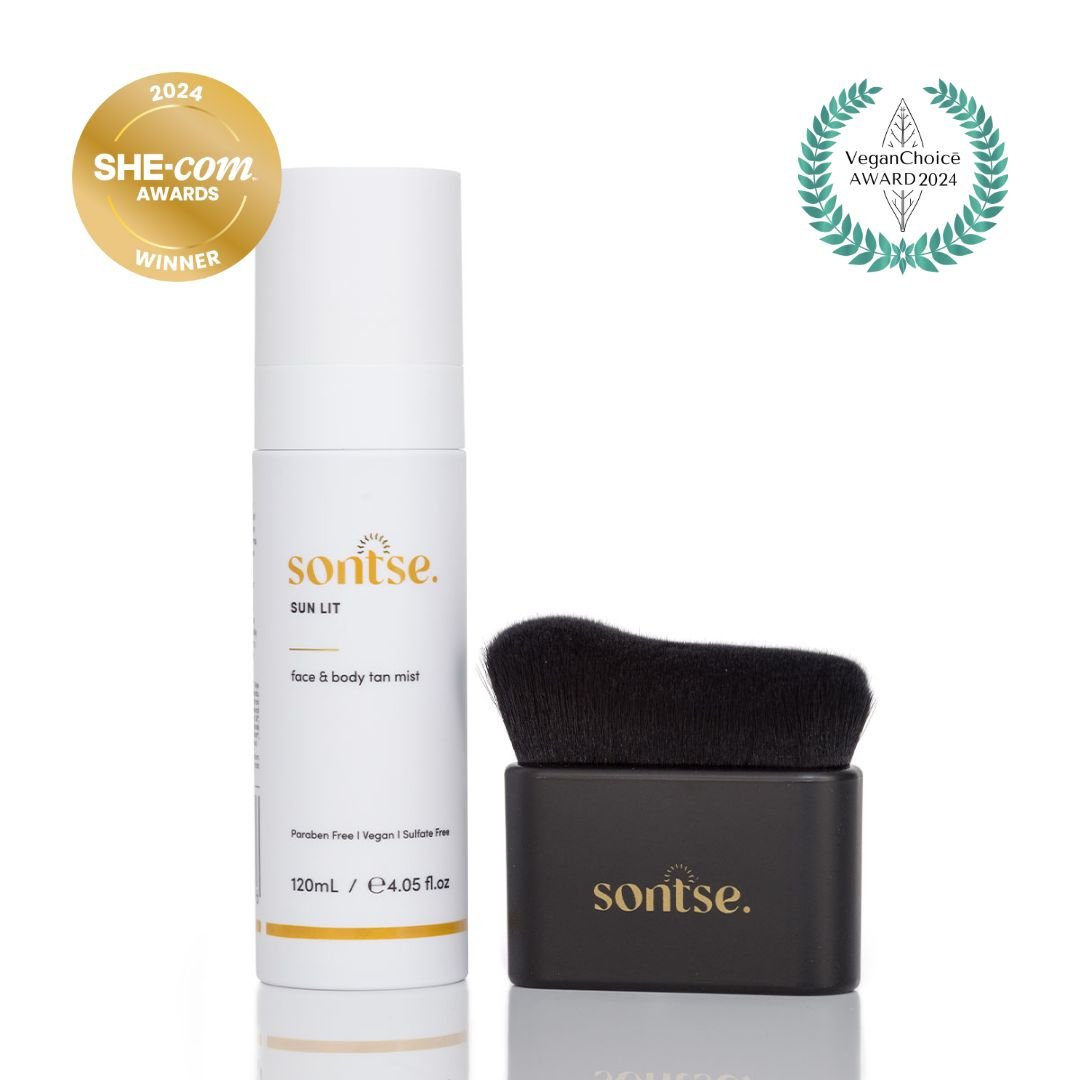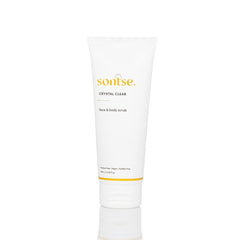*Please be aware, that the below interview shares sensitive information about Michelle’s personal experience that could bring up a mix of emotions for those who have experienced similar circumstances. If this is you, be gentle with yourself, and allow yourself space to process the incredibly challenging journey you’ve been on. Our hearts are for you, we stand with you and hope to see these stories create change.
Q: Michelle, tell us a bit about yourself:
A: Hey, well my name is Michelle. I grew up in NSW and I’m a freelance hairstylist, based in Melbourne.
Q: Can you share a little about your approach to sun safety/skin care growing up and how that evolved in your teens and early twenties?
A: Yeah of course, so where I’m from, growing up near the beach, sun baking and being sun exposed was a 'normal' part of life. I spent most of my childhood, teens and 20’s in the sun. In my teens and 20’s, I’d lay out on the beach lathered head-to-toe in baby oil, not sunscreen, baby oil! I sustained this lifestyle by saying to myself that I was safe as long as I didn’t get burnt! Having olive skin I rarely saw my skin burn or go red, so I thought I was fine.
Q: Can you share why raising awareness and advocating about sun protection, skin cancer and in particular, Melanoma is so important to you?
A: In 2018, when I was 32 years old I was diagnosed with Stage III Melanoma. Then, by 2021 I was Stage IV. I never thought Melanoma would happen to me. I now am so passionate about raising awareness, advocating and joining the conversation whenever I can, about how important sun protection is.
Q: Can we rewind a little bit now and talk about what led to your skin check and diagnosis?
A: Yeah so in August 2018 l noticed a mole on my chest had become asymmetric, the borders had become irregular, a black section had appeared in the middle, the mole was growing in size and it had become itchy.
I booked an appointment to see a local GP (who happened to also specialise in skin cancer detection). I went in early on a Saturday morning and my doctor took one look at it and said 'We need to biopsy that straight away'. I remember seeing the concern in her eyes...
By Saturday night my GP called me and told me my biopsy results had come back positive to Melanoma. I was so shocked. My heart sank. I will never forget that phone call.
Q: We met recently and discussed how your initial diagnosis went from Stage III, quickly to Stage IV. We know this is incredibly difficult and we hope you don't mind us going here, can you please share what led to this and explain a little about in-transit metastasis?
A: So with Melanoma, cells can spread from the primary tumour through the bloodstream and lymphatic system to form new tumours.
With Melanoma, test results will show whether it has spread to other parts of the body. The Melanoma will be given a stage of 0-4. The most important feature of a Melanoma in predicting its outcome is its thickness:
- Stage 0 is less than 0.1mm
- Stage I less than 2mm
- Stage II greater than 2mm
- Stage III spread to lymph nodes
- Stage IV spread to distant skin and/or other parts of the body.
(Source- Cancer Council)
When I was diagnosed with Stage III Melanoma in 2018, it had spread to the nearest lymph nodes in my underarm. When I was diagnosed with Stage IV In-transit Melanoma in 2021 it had spread to my distant skin.
Q: A lot of people may not have heard of this, do you mind sharing what this means and how rare this is?
A: Yeah of course, so in simple terms, in-transit metastasis of Melanoma happens when small tumour lumps form in the skin or just under the skin between the original melanoma site and the nearest lymph nodes. This can occur in about 10% of melanoma patients after the original melanoma has been removed.
Q: How quickly did your in-transit metastasis spread? Do you mind sharing how aggressive this is?
A: In 2021 I noticed the start of numerous brown blisters appearing 2cm away from my primary Melanoma scar line on my chest. It looked like a rash, they were different shapes and sizes, they all had smooth surfaces and they grew very quickly… basically over a space of a few weeks.
According to Kavita et al., (2021), this spreading tends to happen primarily through the body’s lymphatic system, which is like a network of tiny tubes that help fight infections. If small lumps of cancer show up more than 2cm away from where the first tumor was, it’s called in-transit metastases or microscopic satellitosis. This means the cancer is spreading through the skin. About 30% of thicker melanomas (over 3mm deep) show this. When this happens, it usually means the cancer is harder to treat and doctors will consider it more serious.
Q: Treatment looks different for every person; can you share what your treatment plan has looked like since your initial diagnosis?
A: From 2018-2022 I underwent wide excision surgeries, a lymph node biopsy, 41 doses of intravenous Immunotherapy drugs, and five radiation sessions to treat my Stage III & Stage IV Melanoma. Then, I had countless oral steroids, intravenous steroids, and intravenous infliximab for severe immunotherapy side effects like Colitis & Gastritis.
Q: Can you share how often you were getting treatments and what this involved?
A: Each of my Immunotherapy drugs over the years had different treatment regimes, it tended to vary from one intravenous dose every two weeks, three weeks or four weeks. Immunotherapy is a treatment that uses the body’s own immune system to fight cancer. My Immunotherapy treatments were done intravenously in day therapy.
Q: Cancer can change many parts of life, even after treatment and recovery. Would you mind sharing how your diagnosis has impacted your daily life, relationships, health, and finances? We’d love for readers to gain a better understanding if you're comfortable sharing.
A: My Cancer diagnosis has affected my self-worth, my body image, my relationships, my finances, my mental health, how I work, how I live, how I communicate, how I socialise, how I exercise, what I eat, what I drink, intimacy and who I trust. It’s affected most aspects of my life.
Q: What has helped you get through these challenging times, what has been your outlet, your form of self-care?
A: A lot of therapy sessions with my psychologist has helped me through the challenging times. As well as getting out in nature, walking, yoga, and meditation.
Q: What do you hope to see change in skin cancer prevention and diagnosis?
A: I hope skin checks will be free for everyone one day. I hope that raising sun safety awareness and sharing stories like mine helps people understand how important it is to protect themselves from the sun.
Q: If you could share one piece of advice about sun safety with those reading this, what would it be?
A: Please protect the skin you’re in! Use all forms of sun protection when the UV level is 3 or higher: protective clothing that covers as much skin as possible, apply sunscreen every two hours, wear hats, sunglasses and seek shade.
Q: How do you hope to positively impact others by sharing your story?
A: I hope that by sharing my story, I can help raise awareness about the seriousness of melanoma, and its impact, and, most importantly, let those diagnosed know they’re not alone.
Michelle’s story is a powerful reminder that sun safety is essential for everyone, regardless of skin type or how often you burn. If you would like to hear from more individuals in our community and their stories, check out this personal interview with Raylene – a Melanoma Survivor.
Watch Michelle's Story on Instagram
Considering safer alternatives for achieving that sun-kissed glow? Using sunless tanners is one way to enjoy radiant skin without risking exposure to the sun's dangers. Explore our range of sunless tanning solutions and make the choice to protect your skin while still turning up your glow.
References
Kavita, T., Vakharia, M., & MS. (2021). Clinical Diagnosis and Classification: Including Biopsy Techniques and Noninvasive Imaging. Clinics in Plastic Surgery, 48(4), 577-585. https://doi.org/10.1016/j.cps.2021.06.006
Written By Liana Pantalone – Beauty & Skincare Copywriter at Climbing Vine Co.






















